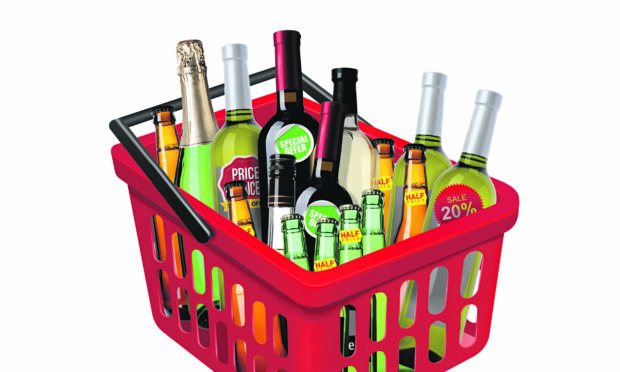
Minimum prices on alcohol have had no effect on Scotland’s worst problem drinkers, research shows.
SNP ministers effectively banned cheap alcohol, promising the policy would slash deaths, hospital admissions and worklessness among the heaviest consumers. But five years on, a fresh study suggests they got it wrong.
It found no change in the behaviour of those whose drinking habits cause the most harm to society and were the original target of minimum unit pricing (MUP).
The study did detect a slight drop in overall alcohol consumption, but the authors conclude: “The lack of evidence for a decline in the prevalence of harmful drinking arising from MUP is contrary to model-based evidence that informed the introduction of the policy.”
Ministers have until next year to decide whether to ditch their experiment and are already under pressure to double down on it by increasing the alcohol price floor.
But a so-called sunset clause in the legislation means MSPs will first have to debate whether MUP has been a success or failure.
Last night, John Duffy – a former Scotland Office adviser and statistician who opposed the policy – said: “The basic flaw in MUP and the modelling behind it was the belief that a spreadsheet could tell you how much people will drink next year.
“Civil servants and ministers love the idea that it’s possible to predict the future, but it’s folly to fall into that trap.
“Parliament was wise to insert a sunset clause into the legislation as this now gives MSPs the opportunity to examine the evidence, which clearly points one way. MUP was specifically designed to target the habits of the heaviest drinkers and it has missed.
“Unfortunately, there are those with a vested interest in persuading ministers to double down and increase the minimum unit price of alcohol, and there is a desperate search for any scrap of data to justify it.”
The research
The latest research is by the same Sheffield University modellers who played a pivotal role in the SNP’s decision to pursue MUP, which was introduced in 2018.
Professor John Holmes led the University’s Alcohol Research Group that attempted to predict the effect of introducing a 50p minimum price for a unit of alcohol.
Their research, adopted by the Scottish Government but rejected by UK ministers, promised it would dampen demand – particularly for products such as cheap cider – among the nation’s 3.5 million drinkers.
Health guidance advises people to have no more than 14 units per week, the equivalent of roughly six pints of lager or a bottle-and-a-half of wine.
Those below that limit – around two thirds of drinkers – are classed as moderate while the quarter who are just above are labelled hazardous.
However, the 10% who are harmful drinkers are men who consume at least 50 units and women 35 units or more.
The majority of the benefits of MUP were to be generated by changing the habits of this particular group.
MSPs were told harmful drinkers would account for around 70% of the 39,000 fewer hospital admissions and 2,000 less deaths in the policy’s first 20 years, according to the Sheffield team, which in total would save the NHS more than £200 million.
Another £50 million could be saved by a cut in crime, with half of the fewer offences attributed to the heaviest consumers of alcohol.
Around 1,300 problem drinkers would also return to work, saving the taxpayer around £500 million over two decades.
However, the vast majority of this massive windfall depended on MUP affecting the behaviour of the estimated 350,000 Scots in the harmful category.
The latest research – set to be published in the journal Public Health – analysed the alcohol consumption diaries of 38,674 Scots between January 2009 and February 2020, just before the pandemic began.
The study found that, since MUP was introduced in May 2018, there has been no change in the proportion of harmful drinkers. A small drop of 3.2 units per week in their consumption was “not robust” and disappeared when adjusted for the introduction of Universal Credit, which changed the regularity of benefit payments.
The report – of which Prof Holmes is an author – concludes: “The results suggest the introduction of MUP in Scotland did not lead to a decline in the proportion of adult drinkers consuming alcohol at harmful levels.
“It also did not lead to any change in the types of alcoholic beverage consumed by this group, their drinking patterns, the extent to which they consumed alcohol while on their own or the prevalence of harmful drinking in key subgroups.”
The latest report found a small but statistically-significant shift away from mid-range hazardous drinking since 2018.
It corresponded with tiny, insignificant increases in the harmful and moderate categories.
Three previous studies have suggested MUP has successfully targeted the heaviest drinkers – though they looked at purchase data for around 3,000 households rather than Sheffield’s more rigorous analysis of 39,000 consumption diaries.
Some data has shown MUP accelerating the decline in Scotland’s appetite for alcohol – on a downward trend since 2003 – but a series of studies has also shown no benefit.
Last year, research found a predicted drop in road collisions had not occurred, and a review for Public Health Scotland (PHS) found MUP had even pushed some heavy drinkers into greater poverty.
In 2020, a study suggested hospital A&E departments had become even busier as a result.
Prof Holmes said he was convinced that MUP is working but is unsure why his latest study found the opposite.
He said: “We were a little surprised, however, we often see contradictory results when we evaluate policies using lots of different data sets and methods. It is important we look at all the evidence in the round.
“The most likely explanation for our findings is limitations in the way our survey data measure harmful drinking.
“The Scottish Government and Parliament will decide whether to continue with MUP after the sunset clause, but I see good reasons for them to continue with it.”
Alison Douglas, chief executive of Alcohol Focus Scotland, added: “Individual studies, using different data-sets, have shown different levels of effects from minimum price on consumption by harmful drinkers. Importantly, however, recent findings from PHS show MUP has prevented significant numbers of deaths and hospitalisations from chronic alcohol-related conditions.
“It is vital it is retained and the price level uprated so more people in Scotland can benefit from this life-saving policy.”
Drugs and Alcohol Policy Minister Elena Whitham described MUP as “world-leading”.
She added: “Recent research found around 150 deaths and 400 hospital admissions attributable to alcohol each year have been averted since the policy was introduced, with the largest reductions in our most deprived areas.”
The expert view
By Owen Good, Head of Economic Advisory for the Centre for Economics & Business Research (CEBR)
The aim of alcohol market interventions is typically to reduce the consumption of heavy drinkers, who are disproportionately associated with alcohol-related harm.
However, heavy and harmful drinkers tend to be those most dependent on alcohol. In turn, this dependency means they reduce consumption the least when faced with a higher price.
CEBR has repeatedly argued this point when evaluating price-based interventions such as MUP. However, this has not always been accepted by other researchers – notably Sheffield University’s Alcohol Research Group, whose modelling was influential in MUP’s introduction.
Unfortunately, results emerging from Scotland over the last several years, including the latest Sheffield study and those by Public Health Scotland, continue to bear out underwhelming results for the policy.
While alcohol consumption overall is slightly down, MUP has not has the dramatic effect desired or predicted on reducing the impact on the most harmful consumers.
Designing effective alcohol policy is inherently challenging. However, policies that attempt to tackle the root cause of alcohol abuse are likely to be more impactful than simply policies that increase the cost of products, especially those dependent consumers will continue to buy.

Enjoy the convenience of having The Sunday Post delivered as a digital ePaper straight to your smartphone, tablet or computer.
Subscribe for only £5.49 a month and enjoy all the benefits of the printed paper as a digital replica.
Subscribe